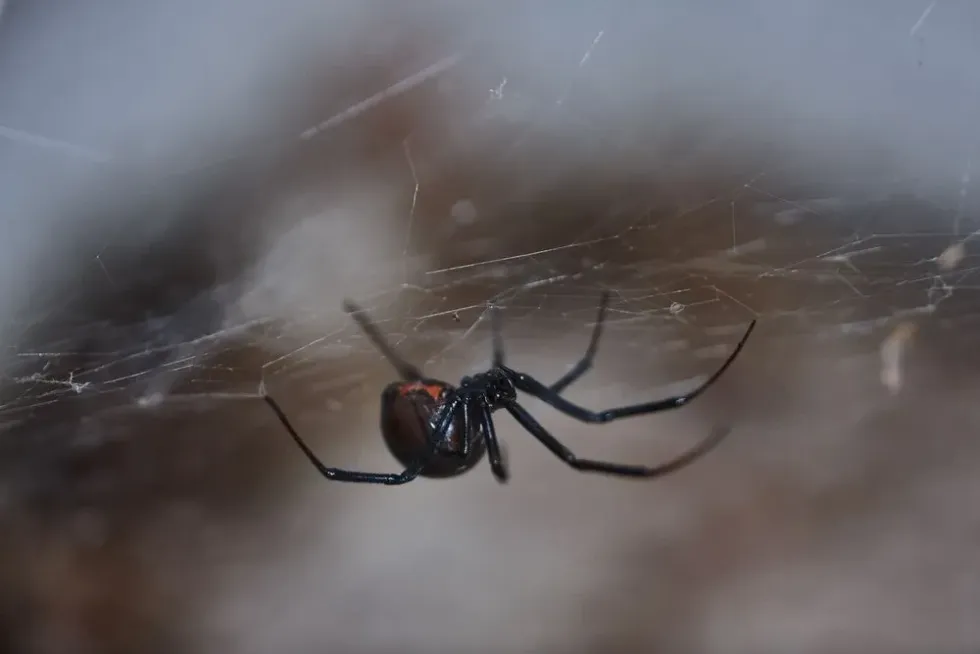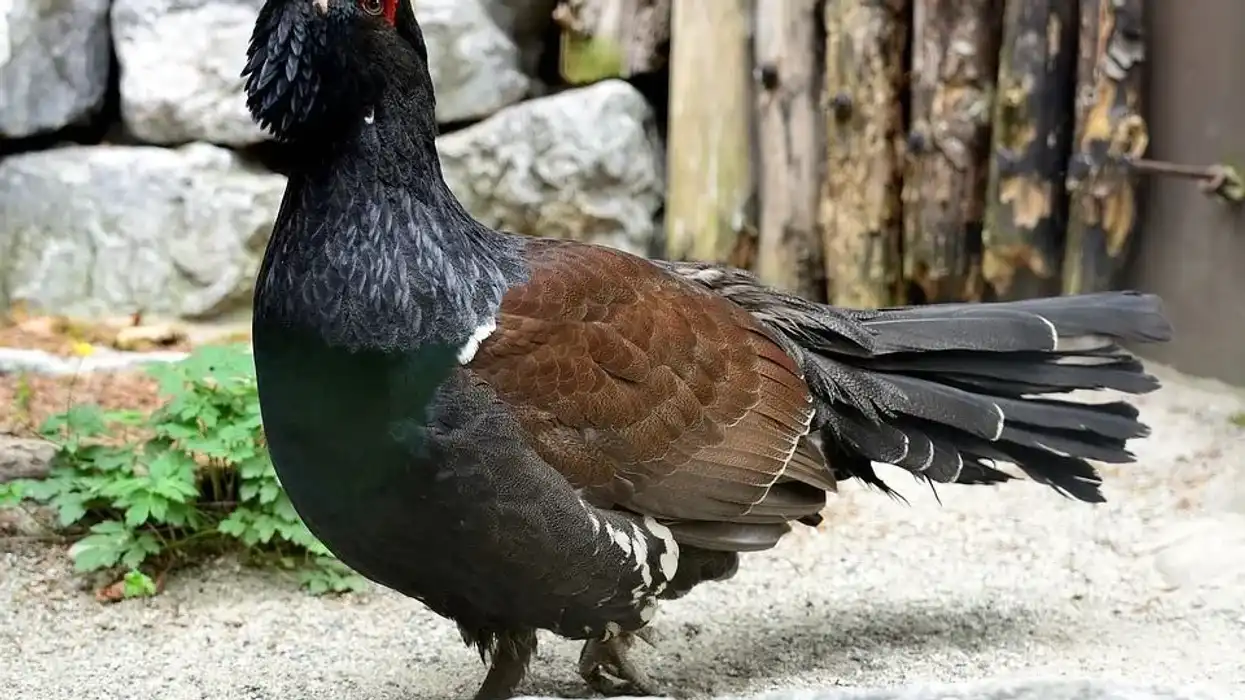Western black widows are spiders found in the North American continent. More specifically, they are found in the four deserts in the United States of America, the Great Basin, Sonoran, Chihuahuan, and Mojave deserts.
These spiders often live and breed close to human settlements in places like trash cans, under rocks, and inside houses. The bites of western black widow spiders are highly venomous but rarely fatal.
This is because these inject a very low amount of venom with their bites. They can however cause discomfort and people aged below 16 and above 60 can feel some complications. These spiders are known for their females which are more dominant and live longer than the males.
This species exhibits cannibalism among adults and juveniles. The adult female often kills and eats the adult male black widow after mating.
And their identifying feature is the red hourglass shape on their abdomens. Since these spiders live close to humans, their conservation status has not been evaluated by the IUCN.
For more relatable content, check out these curly hair tarantula facts and orb-weaver spider facts for kids.
Western Black Widow Interesting Facts
What type of animal is a western black widow?
The western black widow (Latrodectus hesperus) is a spider.
What class of animal does a western black widow belong to?
The western black widow (Latrodectus hesperus) belongs to the Arachnida class of animals. It can also be said to be an arthropod.
How many western black widows are there in the world?
The western black widow (or western widow) is a prolific reproducer and is found close to human habitats, so it is unclear how many western black widow spiders exist in the world.
Where does a western black widow live?
The western black widow lives in North America, mainly in the United States of America. These spiders like living in warm regions, more specifically in the four American Southwest deserts, namely Great Basin, Sonoran, Chihuahuan, and Mojave deserts. It is also abundantly found among human settlements.
What is a western black widow's habitat?
The western black widow (or western widow) likes to live under rocks, plants, ledges, and debris. These spiders build their webs inside trash cans, houses, and even on the ground.
Who do western black widows live with?
Western black widow spiders live and feed alone, except for when they breed.
How long does a western black widow live?
The male of the western black widow spider species lives for about four months, whereas the female live much longer, close to 1.5 years. This is because the female is very likely to have killed the male after mating.
How do they reproduce?
Western black widow spiders reproduce by mating and laying eggs in a papery and tan or white egg sac. Males are known to wander without feeding or biting when they look for a female.
They carry sperm on their receptacles of pedipalps which are placed in the genital openings of female black widows. Females are known to make 4-9 egg sacs and a single egg sac may contain up to 750 eggs. Newborns hatch after two weeks of incubation in the egg sac and are known to indulge in cannibalism.
30 days after hatching, only 1-12 spiders actually live. Male black widows mature after 70 days and female black widows mature after 90 days.
What is their conservation status?
Since western black widow spiders are rather prolific multipliers and they live close to human habitats, their Conservation Status is Not Evaluated in the IUCN.
Western Black Widow Fun Facts
What do western black widows look like?
Females of the western black widow spiders are shiny and black. Their most prominent feature is the red hourglass shape on their abdomens.
Females are twice as big as male black widows and they have round abdomens. Females also have a reddish tip on their abdomens.
Males, however, have longer legs than females and are more tan-colored with light stripes. Males also have red and yellow bands and spots on their dorsal sides. Also, the color of the hourglass is a fainter orange-yellow.
When they're born, western black widow spiders are a white or a yellow-white color. They get blacker as they mature of course, and the amount of white and red on their bodies is also variable.
Spiderlings have gray or olive-colored topsides and yellow or white stripes. Male and female spiderlings do not exhibit significant sexual dimorphism like the adults, but both have the hourglass pattern on their undersides.

How cute are they?
The western black widow spider isn't exactly a cute animal, but it does have a certain beauty about it.
The striking red hourglass on their abdomen is the crown jewel that adorns its shiny black body. It has long legs and the female exercises dominance over the male black widow.
The life cycle and habits of this spider are more interesting than its appearance, as the female is known to kill the male black widow after mating, and the juveniles actively compete against each other for survival, indulging in cannibalism.
How do they communicate?
Since they are spiders, western black widow spiders communicate through pheromones or chemical cues. They are also known to leave behind trails of silk rich with pheromones for other spiders to pick up and identify them.
Pheromones can relay information about a spider's maturity, history, and readiness to mate. Western black widow spiders may also use touch to communicate with each other, by building webs and feeling their vibrations.
How big is a western black widow?
Western black widows are 0.3-0.6 in (7.6-15.2 mm) long, with the female's body being larger than that of the male. This makes them 20 times smaller than the Goliath birdeater.
How fast can western black widows move?
Black widows may move close to the speeds of 1 mph (1.6 kph).
How much does a western black widow weigh?
On average, a western black widow weighs 0.9 oz (25 g).
What are the male and female names of the species?
Males and females of the western black widow species do not have specific names. Although, the 'widow' in their names comes from the fact that females sometimes kill males after mating, hence becoming 'widows'. Females hence live much longer and are larger too, with the species being collectively named after them.
What would you call a baby western black widow?
A baby western black widow would be called a 'spiderling'.
What do they eat?
Western black widows eat insects, beetles, cockroaches, flies, darkling beetles, ground beetles, weevils, ants, bumblebees, wasps.
The western black widow also indulges in cannibalism. They eat their own kind if food is scarce or if it is starving, or in self-defense. Females sometimes kill males after mating, and the newly hatched spiderlings also feed on each other, more so if not properly looked after by the mother.
The western black widows are themselves preyed upon by mud dauber wasps.
Are they poisonous?
Yes, the western black widow is a poisonous and venomous spider. In fact, the venom of a western black widow spider is 15 times more toxic than that of a rattlesnake's.
But the amount of this potent venom that a western black widow bite expels is way less than what a rattlesnake injects, which is why western black widows are rarely fatal. Bitten people recover within 2-5 days and when initially bitten, one should wash the area with water and soap and use cold compresses.
Would they make a good pet?
No, they do not make good pets since they carry very potent venom in their bodies and they multiply quickly and live close to human surroundings. In fact, if you find a western black widow in your home, you must get rid of them using things like vinegar and pesticides.
Their egg sacs should be removed but they shouldn't be touched by naked skin.
Did you know...
The family, genus, species that the western black widow spider belongs to are Theridiidae, Latrodectus, L. hesperus. The genus Latrodectus consists of other North American spiders like the southern black widow spider and the northern black widow spider.
The western black widow spider is known to change its web-spinning habits according to situations. If it is well-fed, it does not waste energy specifically for capturing prey. Silk investment in the spider's web is also reduced when egg sacs are to be laid since the egg sacs need to be made with silk too.
The three-dimensional web of the western black widow spider is largely unorganized. The web is built in crevices and corners, or in soil and cactuses in the desert. The web is very strong and sticky.
If a web is found to be active, it is very likely that a female spider is nearby the web. The silk of the web also has adhesive properties.
At the center of the web is the fiber that has adhesive droplets in liquid protein form. When this silk web is rubbed against fingers, the texture is rubbery. The adhesive droplets in the web are bigger than the diameter of the fiber and can be seen by the naked eye.
The instances of deaths caused by black widow spiders are very low. Black widow spiders only bite when disturbed, and most people survive.
Some interesting facts about the black widow spiders are they are all 15 times as poisonous as rattlesnakes, but rarely cause death because of the low volume of venom they inject during a bite. So they are dangerous.
They get preyed upon by wasps mostly, along with some birds. Some of the black widows do not have prominent red hourglass shapes on their abdomens. Black widows are nocturnal creatures.
Is the western black widow spider poisonous?
Yes, western black widow spiders are indeed poisonous. They are famously known for being more poisonous than rattlesnakes!
Even though they are 15 times as poisonous, western black widows do not expel as much venom as rattlesnakes in one bite. The amount of venom is very low and hence a person rarely ever dies, if ever when bitten by a western black widow.
Their bites can be painful and cause some problems inside the body like abdominal pain, swelling of the eyelids and feet, sweating, and dry mouth. They can cause more discomfort in people younger than 16 and older than 60, rarely causing failure of the heart or lungs.
Here at Kidadl, we have carefully created lots of interesting family-friendly animal facts for everyone to discover! For more relatable content, check out these whip spider fun facts and southern house spider fun facts for kids pages.
You can even occupy yourself at home by coloring in one of our Black Widow Spider coloring pages.









